
Toshiba EMI Odeon and Apple Label
07. Help! (OP-7387, OP/AP-8151)
(Update: 20th. April 2024)

 Odeon 1st. Sleeve |
|
| TITLE | HELP! |
||||
| CATALOG NUMBER | OP-7387 |
||||
| RELEASE DATE | 15th September.1965 / First Press |
||||
| TRACK LISTING | SIDE 1 | SIDE 2 | |||
| Help! |
Act Naturally |
||||
| The Night Before |
It's Only Love |
||||
| You've Got To Hide Your Love Away |
You Like Me Too Much |
||||
| I Need You |
Tell Me What You See |
||||
| Another Girl |
I've Just Seen A Face |
||||
| You're Going To Lose That Girl |
Yesterday |
||||
| Ticket To Ride |
Dizzy Miss Lizzy |
||||
| FRONT --> Click! | BACK --> Click! | SIDE 1 --> Click! | SIDE 2 --> Click! | DISK | |
 |
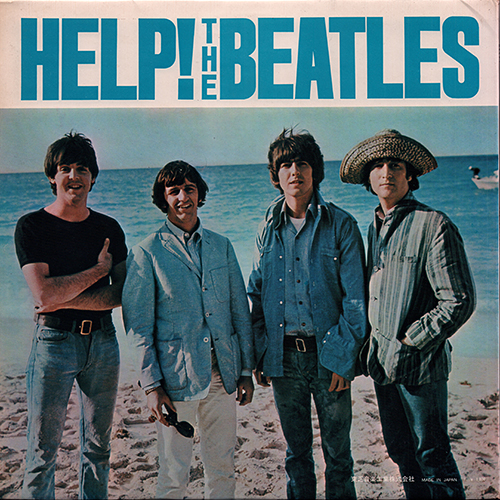 |
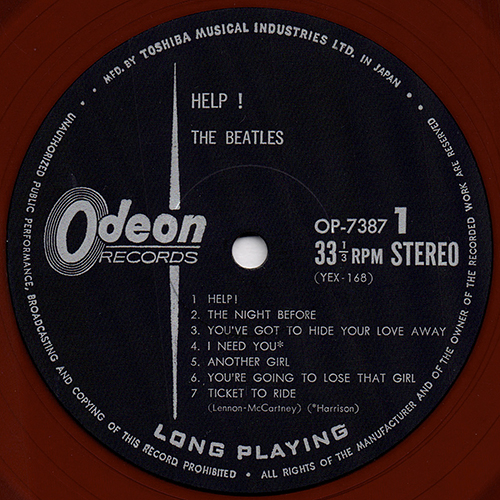 |
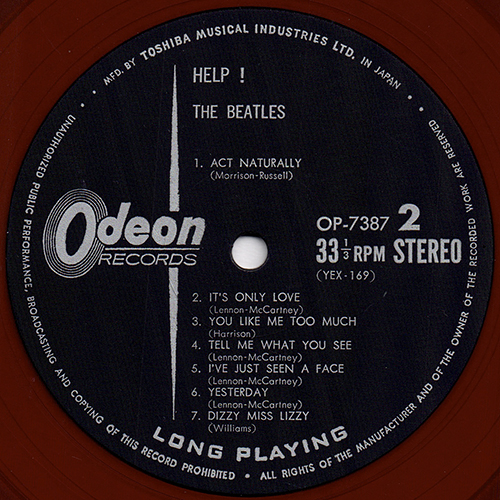 |
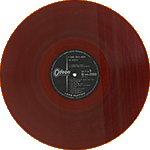 |
|
| INSIDE (Gatefold Cover) |
LYRIC SHEET (Slip Type) | ||||
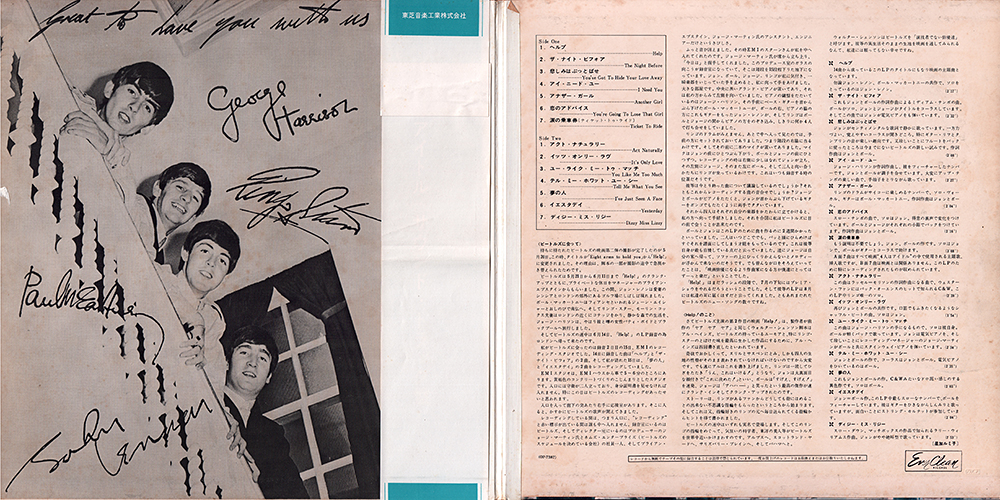 |
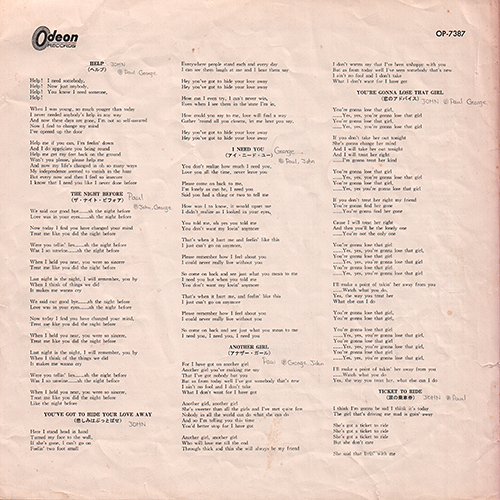 |
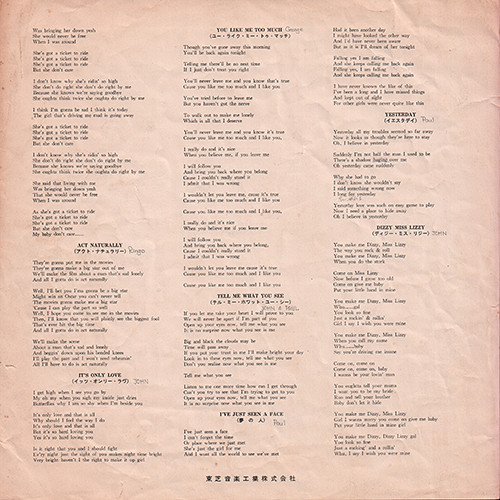 |
The lyric sheet is slip
sheet type. |
||
| LYRIC SHEET (Slip Type): CLOSE UP |
|||||
 |
 |
"Toshiba Musical Industries Ltd." was printed on the lyric sheet. | |||
| INNER SLEEVE |
INNER SLEEVE CLOSE UP |
||||
| FRONT --> Click! | BACK --> Click! | ||||
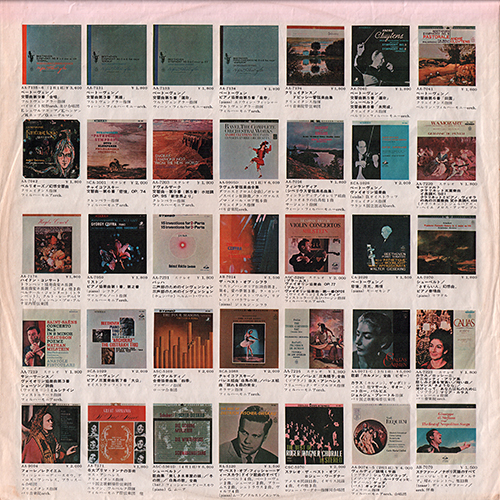 |
 |
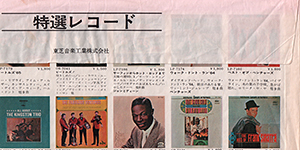 |
The original colour "advert" inner bag has a fold-over flap at the top of the bag to prevent the record from falling out. | ||
| Light Blue OBI CLOSE UP | |||||
| FRONT --> Click! | BACK --> Click! | ||||
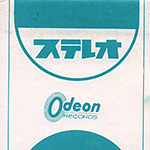 |
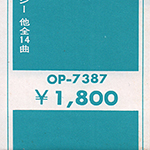 |
1st. pressing had a light blue / white OBI
and priced ¥1,800 on obi strip. The word "STEREO
(Japanese)", Odeon logo mark and catalog number "OP-7387"
were printed on the front. |
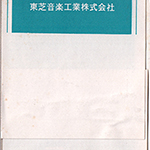 |
There is no order sheet on the
back side of the Obi. |
|
| FRONT AND BACK COVER CLOSE UP | |||||
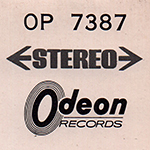 |
 |
||||
| Odeon
logo mark and catalog number "OP 7387" were printed at the
upper right of the front cover. "G-¥1,800", and "Toshiba Musical Industries Ltd." were printed at the bottom of the back cover. |
|||||
| COVER INSIDE CLOSE UP | |||||
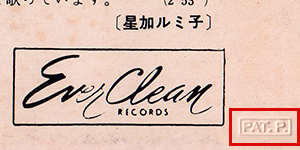 |
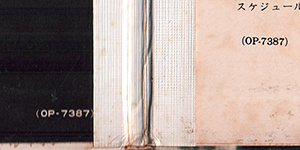 |
"EverClean" logo was
printed on the inside. The words "PAT.P" in the box was embossed at the right side of the "EverClean" logo. Liner notes: Rumiko Hoshika. |
|||
| BACK COVER CLOSE UP | |||||
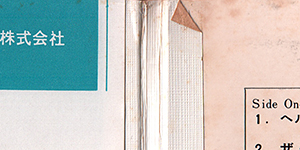 |
The
bookbinding tape is bonded to a part of the inside cover. |
||||
| LABEL CLOSE UP | |||||
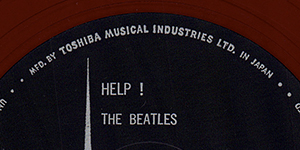 |
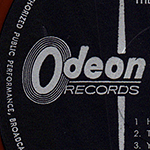 |
Toshiba
pressed a lot of their records on red, "Everclean" vinyl
from 1958 through 1974 (maybe). The Everclean vinyl
was designed to be less prone to collecting static
electricity and dust than the more common black vinyl. The
words "MFD. BY TOSHIBA MUSICAL INDUSTRIES LTD. IN JAPAN" was
printed at the perimeter. |
|||
| LABEL CLOSE UP | |||||
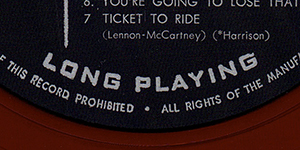 |
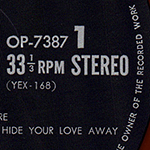 |
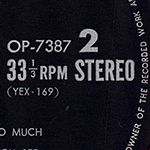 |
The words "LONG PLAYING"
was printed at the bottom of the label. Catalog number and matrix number were printed at the right side of the center hole. |
||
|
OTHER ITEM
|
|||||
| POSTER | This
LP
contains a color poster taken at the time of Bahamas'
location. It is probably thought that it was attached to the first press. |
||||
| FRONT --> Click! | BACK --> Click! | ||||
 |
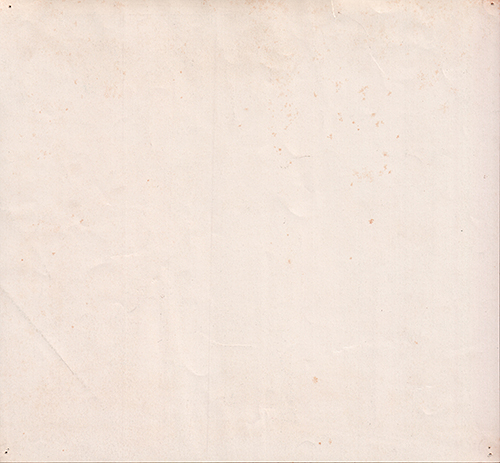 |
||||
|
POSTCARD
(Campaign
Application Postcard)
|
|||||
| FRONT --> Click! | BACK --> Click! |
POSTCARD
CLOSE
UP
|
At
the time of this LP release, a campaign was held in which
"plastic model Beatles doll directly imported from the U.S."
(4 people 1 pair) won. A campaign application postcard was attached to the first edition (part of?). There were 500 winners and the deadline was 20th. Dec. 1965. |
||
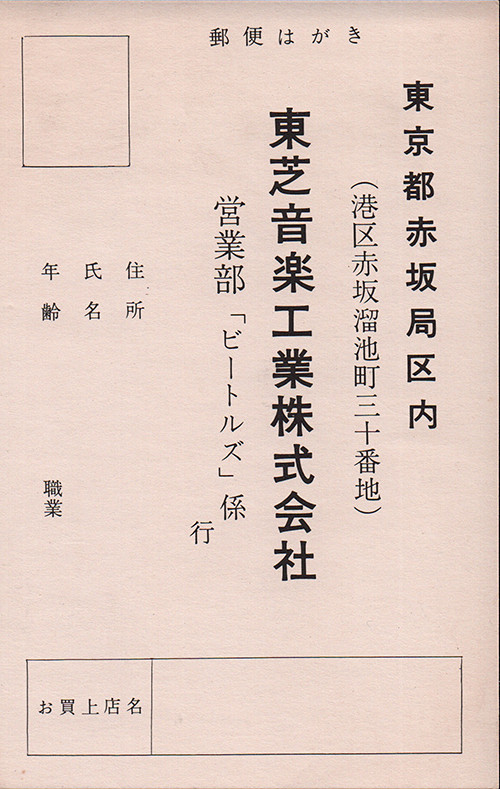 |
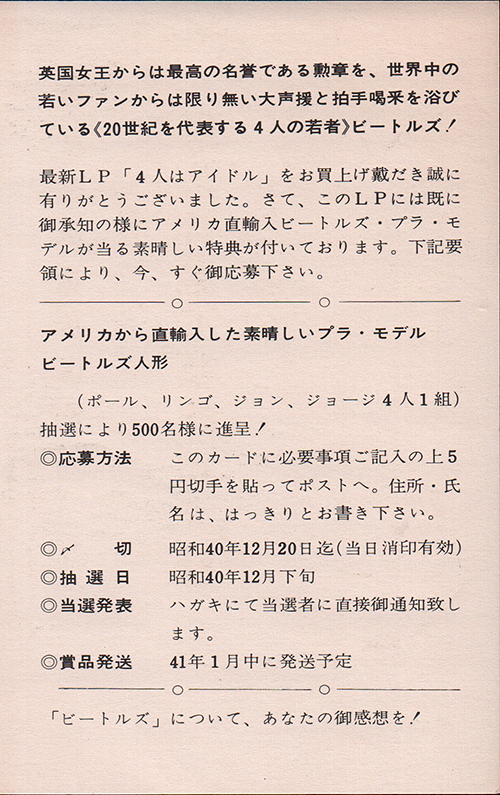 |
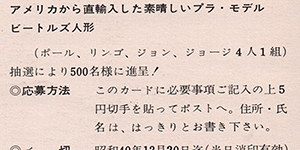 |
|||
| CAMPAIGN
AD |
|||||
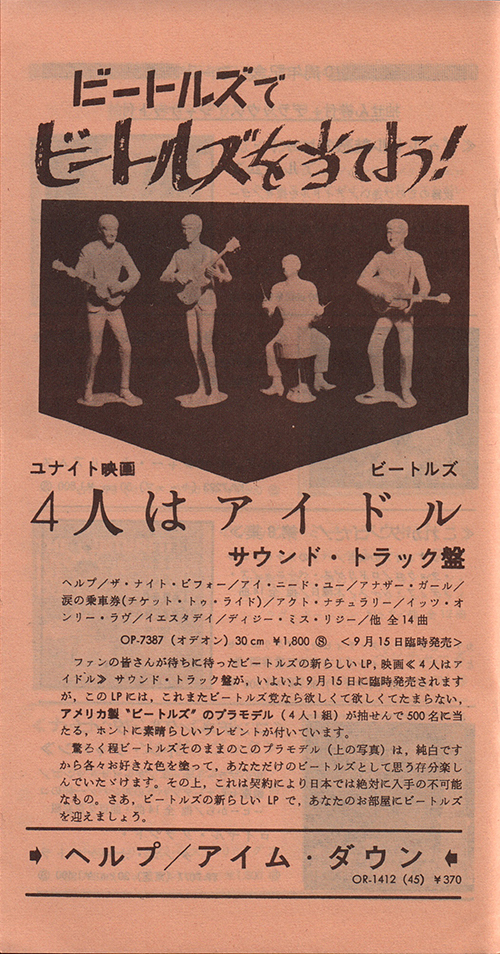 |
AD: CLOSE UP --> Click! |
From
"TOSHIBA Records Monthly Supplement" in October 1965. |
|||
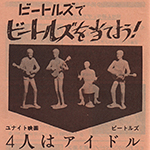 |
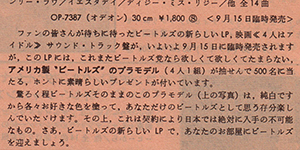 |
||||
| RECORD LABEL | Odeon Label Type-1 (with the words "LONG
PLAYING") |
||||
| MIX | STEREO |
||||
| MATRIX No. | SIDE 1 | YEX-168-2
10 |
|||
| SIDE 2 | YEX-169 16 |
||||
| PRESS MARK | J5 |
||||
| VINYL COLOR | RED |
||||
| RECORD COMPANY'S NAME | SLEEVE | Toshiba
Ongaku kogyo Kabusikigaisha |
|||
| LABEL | MFD. BY
TOSHIBA MUSICAL INDUSTRIES LTD. IN JAPAN |
||||
| SYMBOL/PRICE | G - ¥1,800 |
||||
| LYRIC SHEET STYLE | Slip Sheet Type |
||||
| COVER FORM | Gatefold type. (The bookbinding tape is bonded to a part of the inside cover.) | ||||
| INNER SLEEVE |
The original colour "advert" inner bag
Type-3 |
||||
| OBI |
Light blue Obi / without Order sheet (¥1,800) | ||||
| COVER DESIGN/ PHOTO/ NOTES | Photography Robert Freeman Liner Notes: Rumiko Hoshika |
||||
|
COMMENTS
|
Black Odeon label with
silver print. The words "LONG PLAYING" was printed at the bottom of the label. Gatefold cover. (The bookbinding tape is bonded to a part of the inside cover.) This LP contains a color poster taken at the time of Bahamas' location. It is probably thought that it was attached to the first press. At the time of this LP release, a campaign was held in which "plastic model Beatles doll directly imported from the U.S." (4 people 1 pair) won. A campaign application postcard was attached to the first edition (part of?). There were 500 winners and the deadline was 20th. Dec. 1965. Toshiba released the first Japanese record featuring the Beatles. When this record was released, Toshiba's official name was "Toshiba Musical Industries Ltd." and they used the Odeon label for this and subsequent Beatles releases. Red vinyl: Besides good sound and quality printing, Japanese records also offered some other things of interest to the collector. One of the primary manufacturing companies in Japan, Toshiba, pressed a lot of their records on red, “Everclean” vinyl from 1958 through 1974 (maybe). While not pressed as collectors’ items, these red vinyl pressings are more sought out by collectors than their black vinyl counterparts. The Everclean vinyl was designed to be less prone to collecting static electricity and dust than the more common black vinyl. The obi: "Light blue" Obi It is light blue / white in design with light blue background with the half circle on top. It also features an Odeon logo, catalogue number and price information. While most Japanese records feature local music, a lot of music fans there like foreign music, as well. The language barrier in Japan presented a problem – should foreign album covers be changed for Japanese albums? The solution was the obi, which means “belt” or “sash”. The obi is a strip of paper, usually about two inches wide, that wraps vertically around the album cover, containing information about the artist and album in Japanese. As these strips of paper were fragile and easily torn, they are often missing, especially since consumers in the 1950s and 1960s attached little significance to them. Finding Japanese records made prior to 1970 that still have the obi intact can be quite difficult, and for some albums, nearly impossible. The inclusion of the obi can dramatically affect the price of some Japanese records, sometimes increasing the price by a factor of ten. |
||||
| TITLE | HELP! |
||||
| CATALOG NUMBER | OP-7387 |
||||
| RELEASE DATE | 15th September.1965 / Second Press |
||||
| TRACK LISTING | SIDE 1 | SIDE 2 | |||
| Help! |
Act Naturally |
||||
| The Night Before |
It's Only Love |
||||
| You've Got To Hide Your Love Away |
You Like Me Too Much |
||||
| I Need You |
Tell Me What You See |
||||
| Another Girl |
I've Just Seen A Face |
||||
| You're Going To Lose That Girl |
Yesterday |
||||
| Ticket To Ride |
Dizzy Miss Lizzy |
||||
| FRONT --> Click! | BACK --> Click! | SIDE 1 --> Click! | SIDE 2 --> Click! | DISK | |
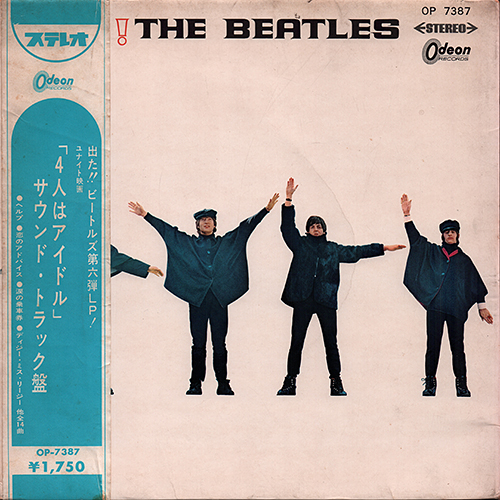 |
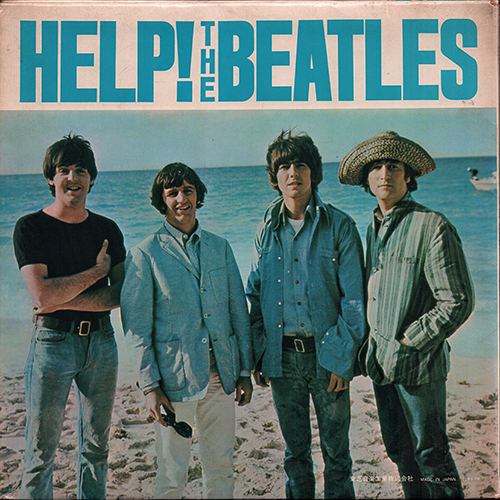 |
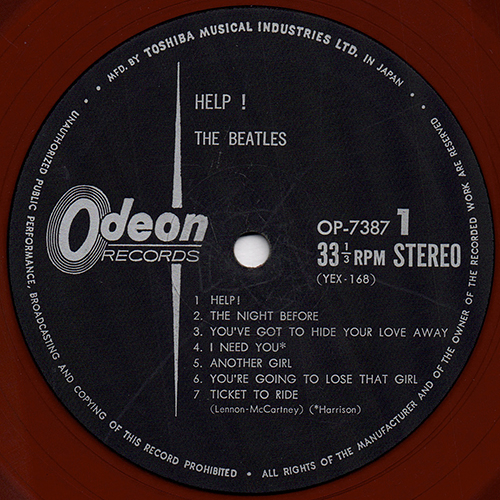 |
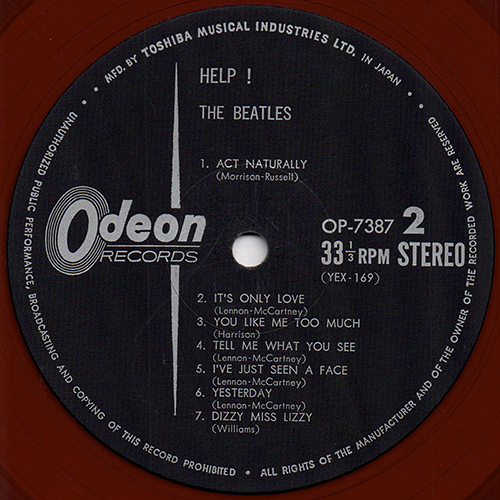 |
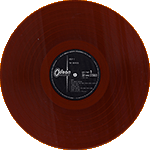 |
|
| INSIDE (Gatefold Cover) |
LYRIC SHEET (Slip Type) | ||||
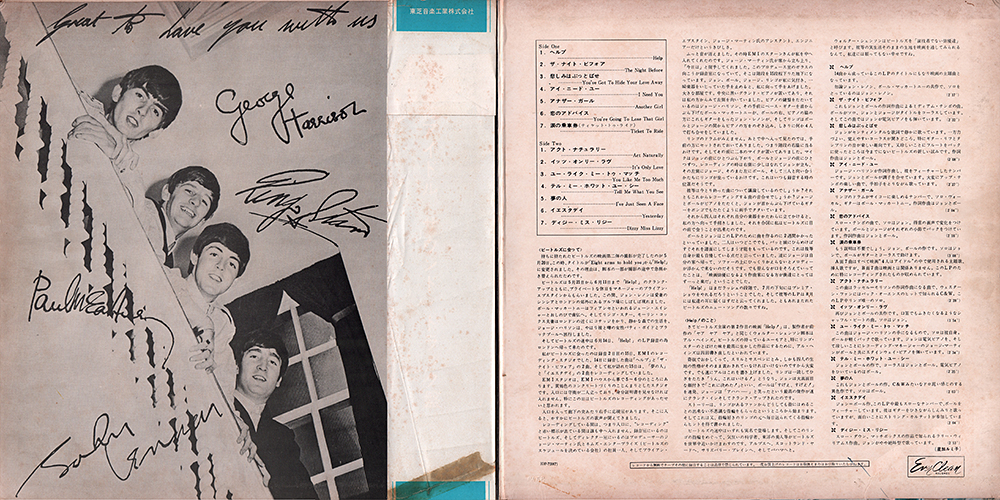 |
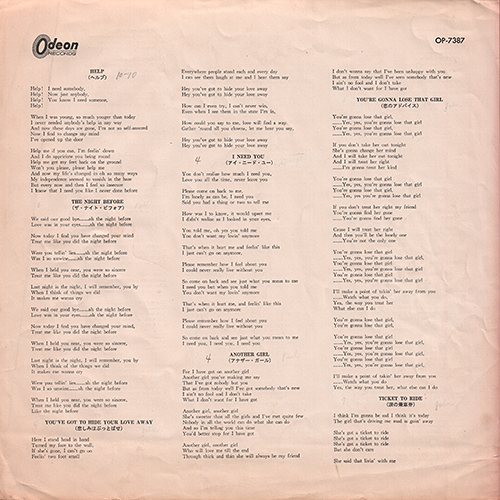 |
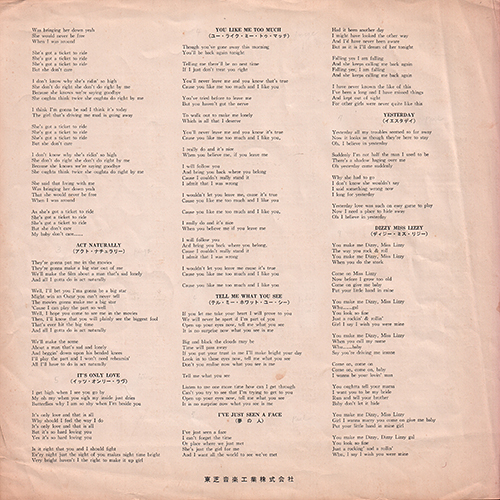 |
The lyric sheet is slip
sheet type. |
||
| LYRIC SHEET (Slip Type): CLOSE UP |
|||||
 |
 |
"Toshiba Musical Industries Ltd." was printed on the lyric sheet. | |||
| INNER SLEEVE |
INNER SLEEVE CLOSE UP |
||||
| FRONT --> Click! | BACK --> Click! | ||||
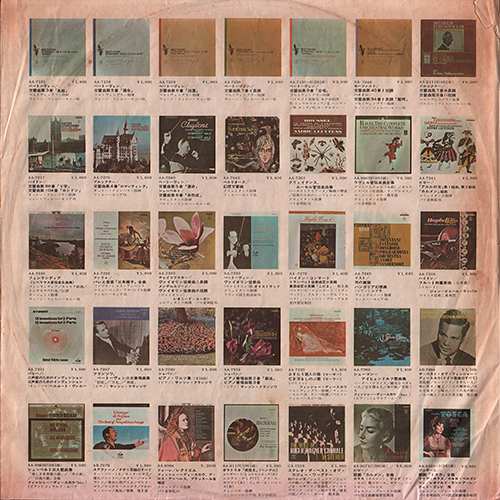 |
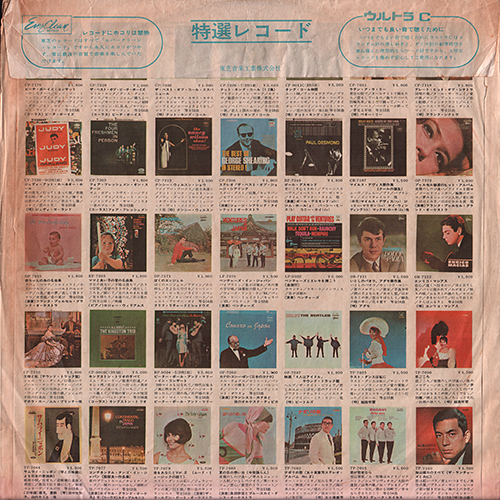 |
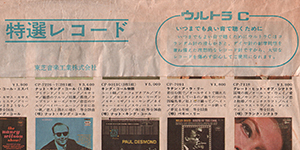 |
The original colour "advert" inner bag has a fold-over flap at the top of the bag to prevent the record from falling out. | ||
| Light Blue OBI CLOSE UP | |||||
| FRONT --> Click! | BACK --> Click! | ||||
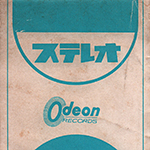 |
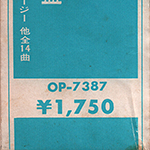 |
2nd. pressing had a light blue / white OBI
and price changed ¥1,750 on obi strip. The
word "STEREO (Japanese)", Odeon logo mark and catalog number
"OP-7387" were printed on the front. |
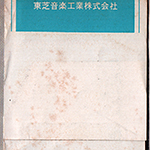 |
There is no order sheet on the
back side of the Obi. |
|
| FRONT AND BACK COVER CLOSE UP | |||||
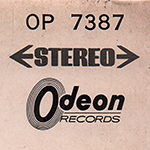 |
 |
||||
| Odeon
logo mark and catalog number "OP 7387" were printed at the
upper right of the front cover. "H ¥1,750", and "Toshiba Musical Industries Ltd." were printed at the bottom of the back cover. |
|||||
| COVER INSIDE CLOSE UP | |||||
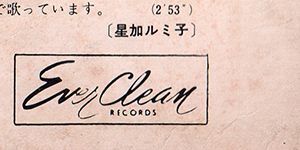 |
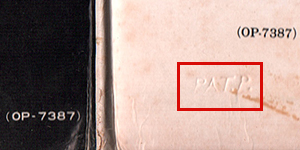 |
"EverClean" logo was
printed on the inside. The words "PAT.P" was embossed at the bottom of the center of the inside. Liner notes: Rumiko Hoshika. |
|||
| BACK COVER CLOSE UP | |||||
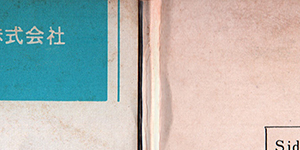 |
The
bookbinding tape did not
use the inside cover. |
||||
| LABEL CLOSE UP | |||||
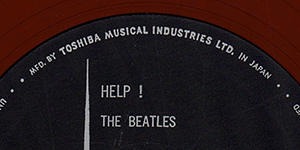 |
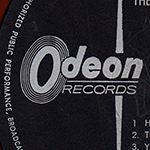 |
Toshiba
pressed a lot of their records on red, "Everclean" vinyl
from 1958 through 1974 (maybe). The Everclean vinyl
was designed to be less prone to collecting static
electricity and dust than the more common black vinyl. The
words "MFD. BY TOSHIBA MUSICAL INDUSTRIES LTD. IN JAPAN" was
printed at the perimeter. |
|||
| LABEL CLOSE UP | |||||
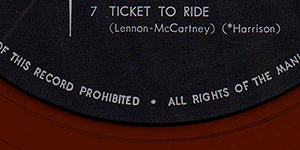 |
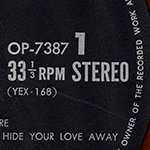 |
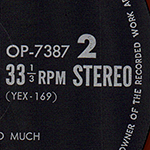 |
The words "LONG PLAYING"
was erased at the
bottom of the label. Catalog number and matrix number were printed at the right side of the center hole. |
||
|
OTHER ITEM
|
|||||
| - |
|||||
| RECORD LABEL | Odeon Label Type-2 (without the words "LONG
PLAYING") |
||||
| MIX | STEREO |
||||
| MATRIX No. | SIDE 1 | YEX-168-2
19 |
|||
| SIDE 2 | YEX-169-3 3 |
||||
| PRESS MARK | 6L |
||||
| VINYL COLOR | RED |
||||
| RECORD COMPANY'S NAME | SLEEVE | Toshiba
Ongaku kogyo Kabusikigaisha |
|||
| LABEL | MFD. BY
TOSHIBA MUSICAL INDUSTRIES LTD. IN JAPAN |
||||
| SYMBOL/PRICE | H -
¥1,750 |
||||
| LYRIC SHEET STYLE | Slip Sheet Type |
||||
| COVER FORM | Gatefold type. (Without the bookbinding tape on the inside cover) | ||||
| INNER SLEEVE |
The original colour "advert" inner bag
Type-4 |
||||
| OBI |
Light blue Obi / without Order sheet
(¥1,750) |
||||
| COVER DESIGN/ PHOTO/ NOTES | Photography Robert Freeman Liner Notes: Rumiko Hoshika |
||||
|
COMMENTS
|
Black Odeon label with
silver print. The words "LONG PLAYING" was erased at the bottom of the label. Gatefold cover. (Without the bookbinding tape on the inside cover.) With the reduction of the excise tax, the price of LP fell to 1,750 yen since August 1966. This LP also corresponded to the price drop, so Toshiba revised the price of OBIs and covers. 2nd. pressing had a light blue / white OBI and price changed ¥1,750 on obi strip. The word "STEREO (Japanese)", Odeon logo mark and catalog number "OP-7387" were printed on the front. "H ¥1,750", and "Toshiba Musical Industries Ltd." were printed at the bottom of the back cover. Toshiba released the first Japanese record featuring the Beatles. When this record was released, Toshiba's official name was "Toshiba Musical Industries Ltd." and they used the Odeon label for this and subsequent Beatles releases. Red vinyl: Besides good sound and quality printing, Japanese records also offered some other things of interest to the collector. One of the primary manufacturing companies in Japan, Toshiba, pressed a lot of their records on red, “Everclean” vinyl from 1958 through 1974 (maybe). While not pressed as collectors’ items, these red vinyl pressings are more sought out by collectors than their black vinyl counterparts. The Everclean vinyl was designed to be less prone to collecting static electricity and dust than the more common black vinyl. The obi: "Light blue" Obi It is light blue / white in design with light blue background with the half circle on top. It also features an Odeon logo, catalogue number and price information. While most Japanese records feature local music, a lot of music fans there like foreign music, as well. The language barrier in Japan presented a problem – should foreign album covers be changed for Japanese albums? The solution was the obi, which means “belt” or “sash”. The obi is a strip of paper, usually about two inches wide, that wraps vertically around the album cover, containing information about the artist and album in Japanese. As these strips of paper were fragile and easily torn, they are often missing, especially since consumers in the 1950s and 1960s attached little significance to them. Finding Japanese records made prior to 1970 that still have the obi intact can be quite difficult, and for some albums, nearly impossible. The inclusion of the obi can dramatically affect the price of some Japanese records, sometimes increasing the price by a factor of ten. |
||||
| TITLE | HELP! |
||||
| CATALOG NUMBER | OP-8151 |
||||
| RELEASE DATE | 5th June.1967 / Third Press |
||||
| TRACK LISTING | SIDE 1 | SIDE 2 | |||
| Help! |
Act Naturally |
||||
| The Night Before |
It's Only Love |
||||
| You've Got To Hide Your Love Away |
You Like Me Too Much |
||||
| I Need You |
Tell Me What You See |
||||
| Another Girl |
I've Just Seen A Face |
||||
| You're Going To Lose That Girl |
Yesterday |
||||
| Ticket To Ride |
Dizzy Miss Lizzy |
||||
| FRONT --> Click! | BACK --> Click! | SIDE 1 --> Click! | SIDE 2 --> Click! | DISK | |
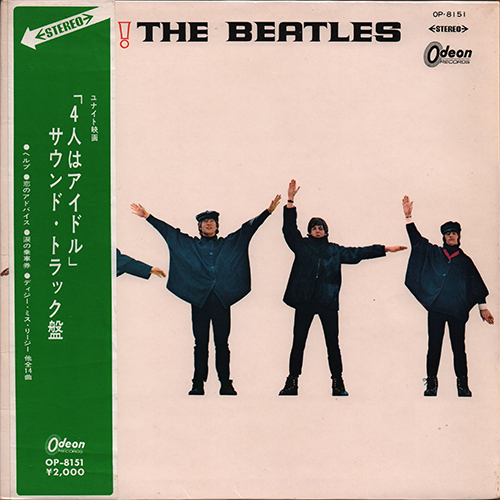 |
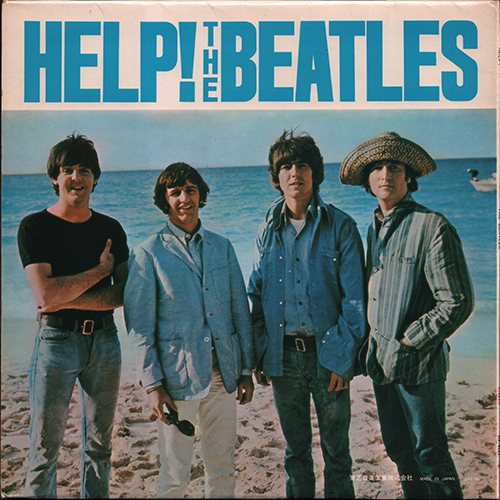 |
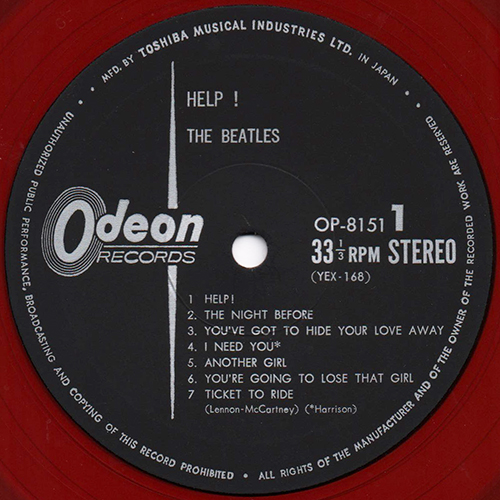 |
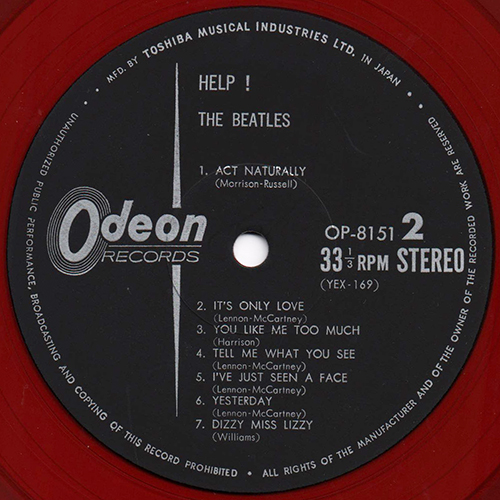 |
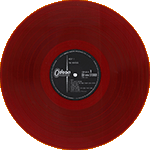 |
|
| INSIDE (Gatefold Cover) |
LYRIC SHEET (Slip Type) | ||||
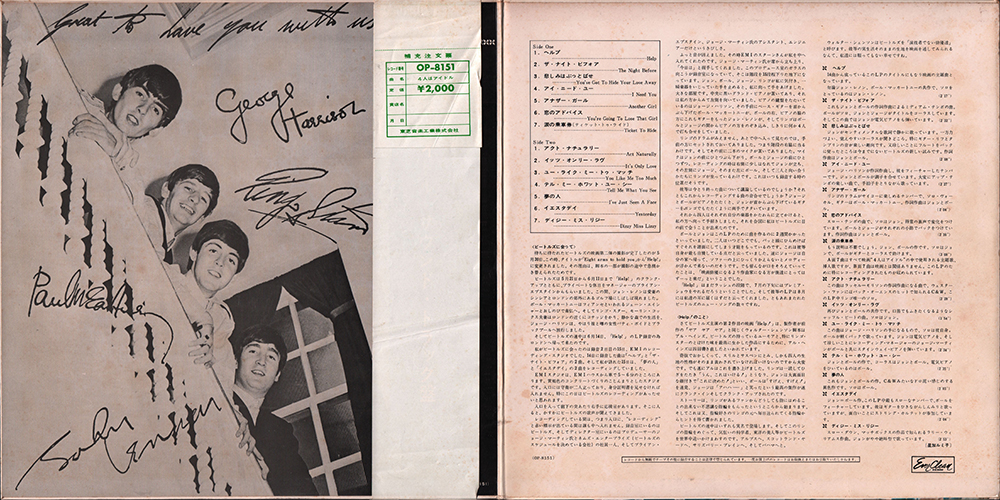 |
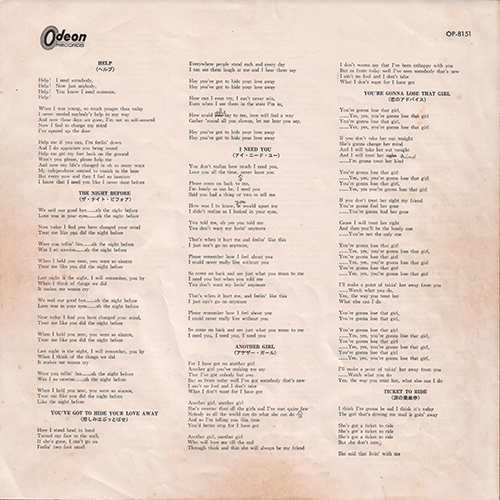 |
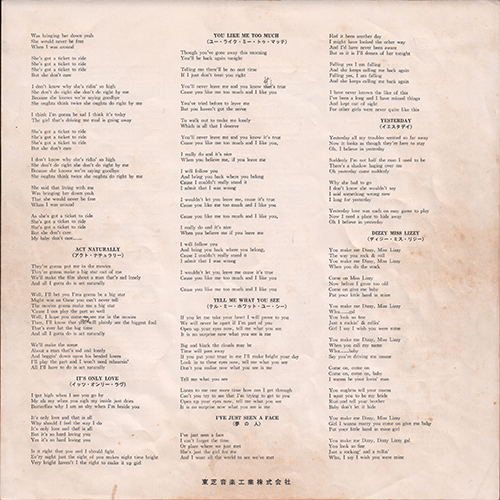 |
The lyric sheet is slip
sheet type. |
||
| LYRIC SHEET (Slip Type): CLOSE UP |
|||||
 |
 |
"Toshiba Musical Industries Ltd." was printed on the lyric sheet. | |||
| INNER SLEEVE |
INNER SLEEVE CLOSE UP |
||||
| FRONT --> Click! | BACK --> Click! | ||||
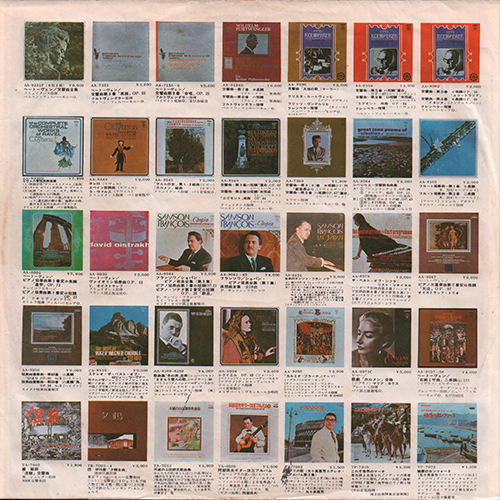 |
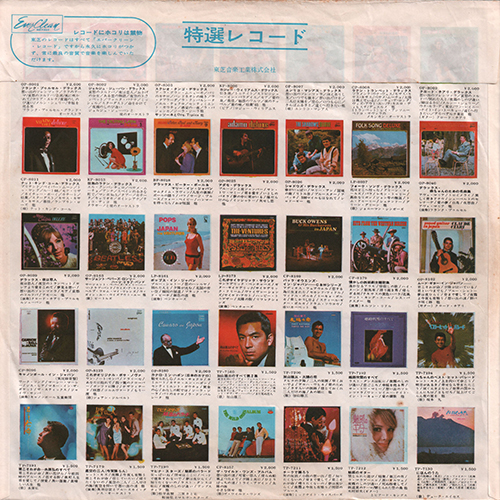 |
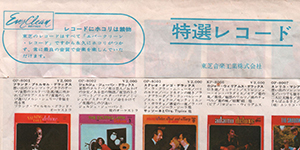 |
The original colour "advert" inner bag has a fold-over flap at the top of the bag to prevent the record from falling out. | ||
| Odeon Green Arrow
OBI CLOSE UP |
|||||
| FRONT | BACK --> Click! | ||||
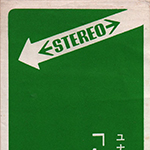 |
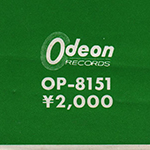 |
3rd. pressing had a green "arrow"
OBI and priced ¥2,000 on rear sleeve and obi strip. |
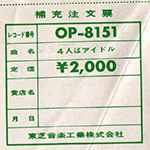 |
The obi remains intact
with the order form on the back uncut. |
|
| FRONT AND BACK COVER CLOSE UP | |||||
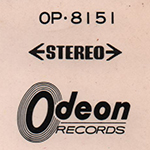 |
 |
||||
| Odeon
logo mark and catalog number "OP-8151" were printed at the
upper right of the front cover. "H ¥2,000", and "Toshiba Musical Industries Ltd." were printed at the bottom of the back cover. |
|||||
| COVER INSIDE CLOSE UP | |||||
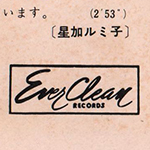 |
"EverClean" logo was printed on the
inside. Liner notes: Rumiko Hoshika. |
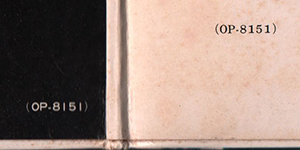 |
The words "PAT.P" was not embossed at the
bottom of the center of the inside. The bookbinding tape did not use the inside cover. |
||
| LABEL CLOSE UP | |||||
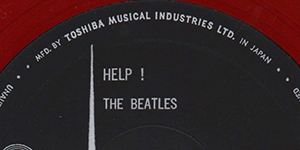 |
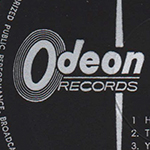 |
Toshiba
pressed a lot of their records on red, "Everclean" vinyl
from 1958 through 1974 (maybe). The Everclean vinyl
was designed to be less prone to collecting static
electricity and dust than the more common black vinyl. The
words "MFD. BY TOSHIBA MUSICAL INDUSTRIES LTD. IN JAPAN" was
printed at the perimeter. |
|||
| LABEL CLOSE UP | |||||
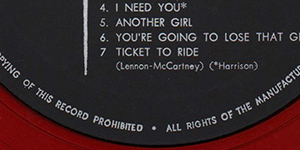 |
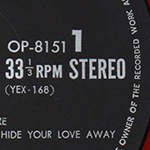 |
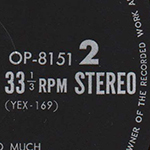 |
The words "LONG PLAYING"
was erased at the
bottom of the label. Catalog number and matrix number were printed at the right side of the center hole. |
||
|
OTHER ITEM
|
|||||
| - |
|||||
| RECORD LABEL | Odeon Label Type-2 (without the words "LONG
PLAYING") |
||||
| MIX | STEREO |
||||
| MATRIX No. | SIDE 1 | YEX-168-2
26 |
|||
| SIDE 2 | YEX-169-2 31 |
||||
| PRESS MARK | K6
> 7J |
||||
| VINYL COLOR | RED |
||||
| RECORD COMPANY'S NAME | SLEEVE | Toshiba
Ongaku
kogyo Kabusikigaisha |
|||
| LABEL | MFD. BY
TOSHIBA MUSICAL INDUSTRIES LTD. IN JAPAN |
||||
| SYMBOL/PRICE | H -
¥2,000 |
||||
| LYRIC SHEET STYLE | Slip Sheet Type |
||||
| COVER FORM | Gatefold type. (without the patent mark) | ||||
| INNER SLEEVE |
The original colour "advert" inner bag
type-6-2 |
||||
| OBI |
Green / white so called "Odeon Arrow" OBI
/ with Order sheet (¥2,000) |
||||
| COVER DESIGN/ PHOTO/ NOTES | Photography Robert Freeman Liner Notes: Rumiko Hoshika |
||||
|
COMMENTS
|
Black Odeon label with
silver print. The words "LONG PLAYING" was erased at the bottom of the label. Gatefold cover. (Without the bookbinding tape on the inside cover.) Taking advantage of the rise in LP prices in 1967, the price of a stereo LP rose to 2,000 yen. Already released Beatles LPs have been reissued with the record number changed to OP-8,000, and the obi changed to an arrow obi. The alphabet symbol and price display on the back of the cover have also been changed to "H ¥2,000". 3rd. pressing had a Odeon green arrow OBI and price changed ¥2,000 on obi strip. The word "STEREO", Odeon logo mark and catalog number "OP-8151" were printed on the front. "H ¥2,000", and "Toshiba Musical Industries Ltd." were printed at the bottom of the back cover. Red vinyl: Besides good sound and quality printing, Japanese records also offered some other things of interest to the collector. One of the primary manufacturing companies in Japan, Toshiba, pressed a lot of their records on red, “Everclean” vinyl from 1958 through 1974 (maybe). While not pressed as collectors’ items, these red vinyl pressings are more sought out by collectors than their black vinyl counterparts. The Everclean vinyl was designed to be less prone to collecting static electricity and dust than the more common black vinyl. The obi: A. K. A."Arrow" Obi 3rd. pressing had a green / white so called "Arrow" OBI and priced ¥1,700 on rear sleeve and obi strip. On June 1967, starting with "Oldies (OP-8016)", numbering for new Odeon LPs changed to the 8000 range numbers. So Obis were renew, A.K.A. Odeon "Arrow Obi" in green and with the same design as the Apple Obis. While most Japanese records feature local music, a lot of music fans there like foreign music, as well. The language barrier in Japan presented a problem – should foreign album covers be changed for Japanese albums? The solution was the obi, which means “belt” or “sash”. The obi is a strip of paper, usually about two inches wide, that wraps vertically around the album cover, containing information about the artist and album in Japanese. As these strips of paper were fragile and easily torn, they are often missing, especially since consumers in the 1950s and 1960s attached little significance to them. Finding Japanese records made prior to 1970 that still have the obi intact can be quite difficult, and for some albums, nearly impossible. The inclusion of the obi can dramatically affect the price of some Japanese records, sometimes increasing the price by a factor of ten. |
||||
| TITLE | HELP! |
||||
| CATALOG NUMBER | OP-8151 |
||||
| RELEASE DATE | June 1967 / CBS SONY Contract
Press |
||||
| TRACK LISTING | SIDE 1 | SIDE 2 | |||
| Help! |
Act Naturally |
||||
| The Night Before |
It's Only Love |
||||
| You've Got To Hide Your Love Away |
You Like Me Too Much |
||||
| I Need You |
Tell Me What You See |
||||
| Another Girl |
I've Just Seen A Face |
||||
| You're Going To Lose That Girl |
Yesterday |
||||
| Ticket To Ride |
Dizzy Miss Lizzy |
||||
| FRONT --> Click! | BACK --> Click! | SIDE 1 --> Click! | SIDE 2 --> Click! | DISK | |
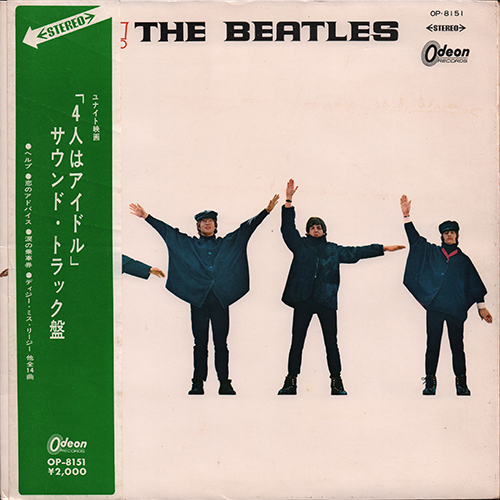 |
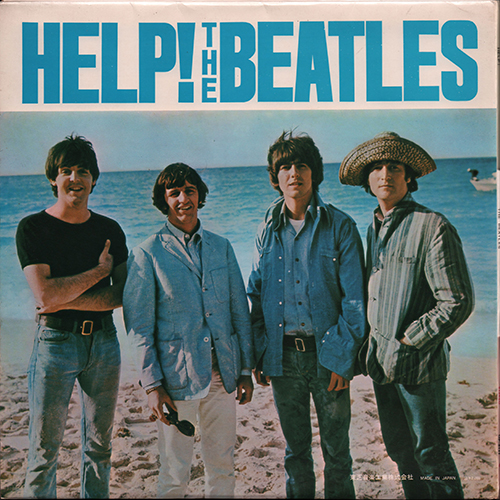 |
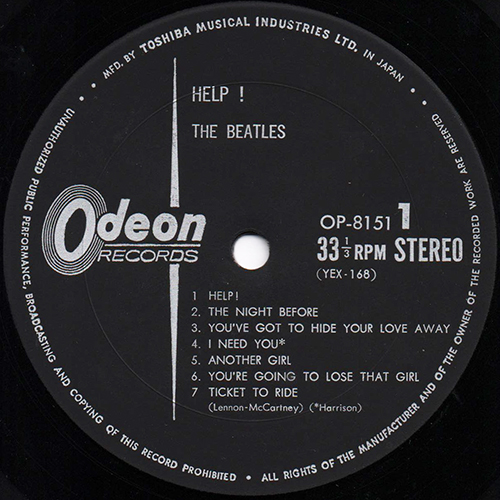 |
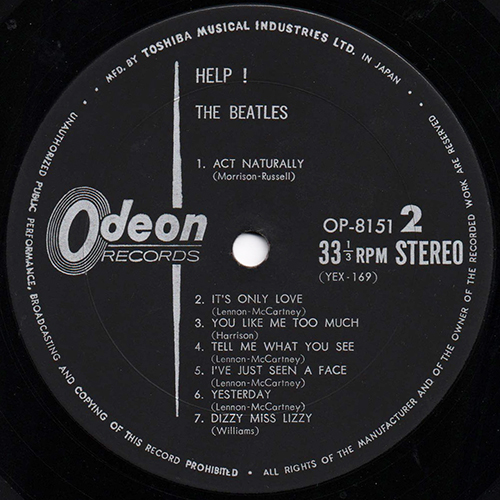 |
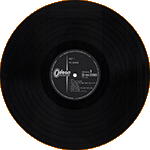 |
|
| INSIDE (Gatefold Cover) |
LYRIC SHEET (Slip Type) | ||||
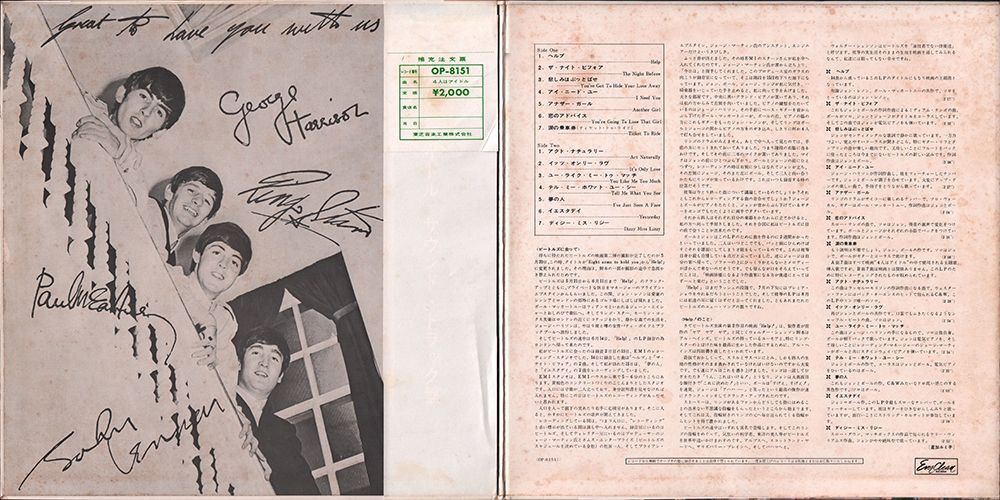 |
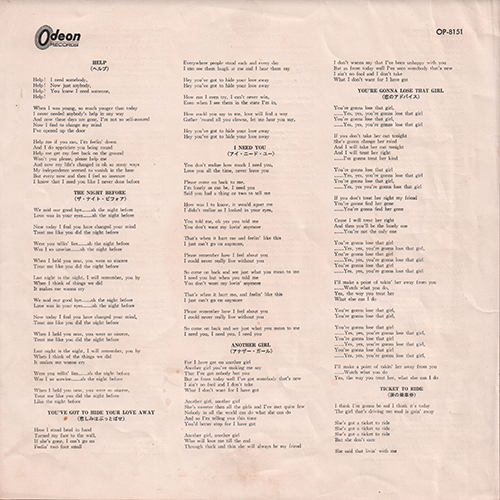 |
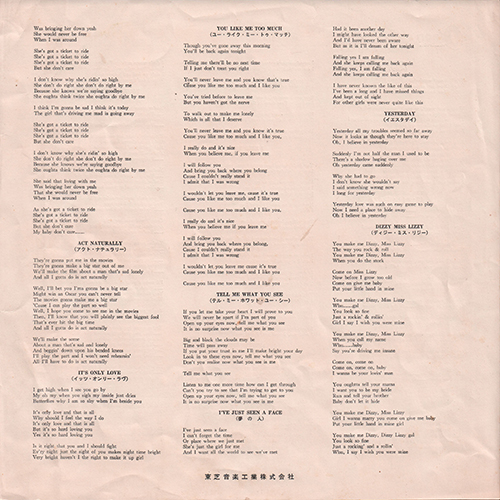 |
The lyric sheet is slip
sheet type. |
||
| LYRIC SHEET (Slip Type): CLOSE UP |
|||||
 |
 |
"Toshiba Musical Industries Ltd." was printed on the lyric sheet. | |||
| INNER SLEEVE |
INNER SLEEVE CLOSE UP |
||||
| FRONT --> Click! | BACK --> Click! | ||||
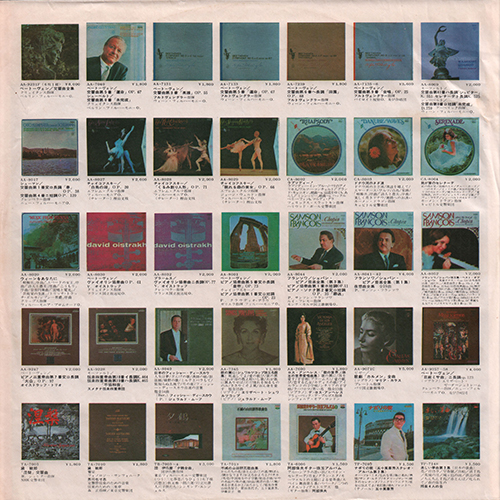 |
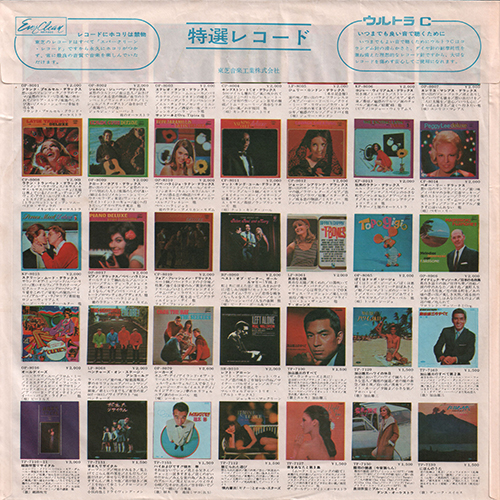 |
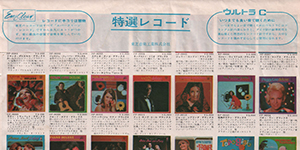 |
The original colour "advert" inner bag has a fold-over flap at the top of the bag to prevent the record from falling out. | ||
| Odeon Green Arrow
OBI CLOSE UP |
|||||
| FRONT | BACK --> Click! | ||||
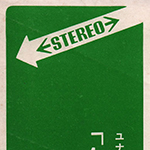 |
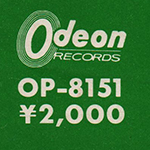 |
3rd. pressing had a green "arrow"
OBI and priced ¥2,000 on rear sleeve and obi strip. |
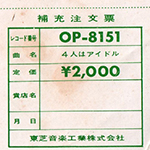 |
The obi remains intact
with the order form on the back uncut. |
|
| FRONT AND BACK COVER CLOSE UP | |||||
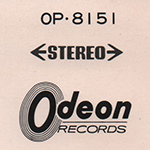 |
 |
||||
| Odeon
logo mark and catalog number "OP-8151" were printed at the
upper right of the front cover. "H ¥2,000", and "Toshiba Musical Industries Ltd." were printed at the bottom of the back cover. |
|||||
| COVER INSIDE CLOSE UP | |||||
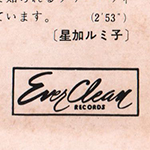 |
"EverClean" logo was printed on the
inside. Liner notes: Rumiko Hoshika. |
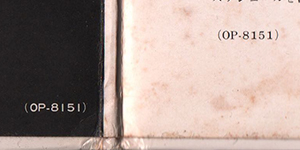 |
The words "PAT.P" was not embossed at the
bottom of the center of the inside. The bookbinding tape did not use the inside cover. |
||
| LABEL CLOSE UP | |||||
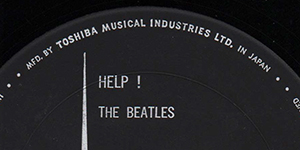 |
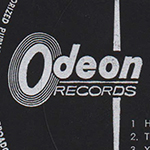 |
Rare Black
Vinyl. Sometimes Toshiba had problems to press enough records to keep up with the demand. To increase production they turned to other companies (Gramophone, CBS SONY etc.) to press up some copies of a particular release. The words "MFD. BY TOSHIBA MUSICAL INDUSTRIES LTD. IN JAPAN" was printed at the perimeter. |
|||
| LABEL CLOSE UP | |||||
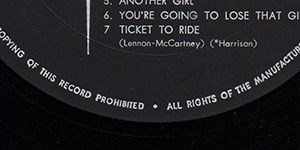 |
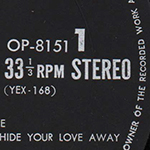 |
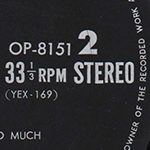 |
The words "LONG PLAYING"
was not printed at
the bottom of the label. Catalog number and matrix number were printed at the right side of the center hole. |
||
|
OTHER ITEM
|
|||||
| - |
|||||
| RECORD LABEL | Odeon Label Type-2 (without the words "LONG
PLAYING") |
||||
| MIX | STEREO |
||||
| MATRIX No. | SIDE 1 | YEX-168-3
21 |
|||
| SIDE 2 | YEX-169-3 18 |
||||
| PRESS MARK | E
S 5 |
||||
| VINYL COLOR | BLACK |
||||
| RECORD COMPANY'S NAME | SLEEVE | Toshiba
Ongaku
kogyo
Kabusikigaisha |
|||
| LABEL | MFD. BY
TOSHIBA MUSICAL INDUSTRIES LTD. IN JAPAN |
||||
| SYMBOL/PRICE | H -
¥2,000 |
||||
| LYRIC SHEET STYLE | Slip Sheet Type |
||||
| COVER FORM | Gatefold type. (without the patent mark) | ||||
| INNER SLEEVE |
The original colour "advert" inner bag
type-6-2 |
||||
| OBI |
Green / white so called "Odeon Arrow" OBI
/ with Order sheet (¥2,000) |
||||
| COVER DESIGN/ PHOTO/ NOTES | Photography Robert Freeman Liner Notes: Rumiko Hoshika |
||||
|
COMMENTS
|
Black Odeon label with
silver print. The words "LONG PLAYING" was not printed at the bottom of the label. Gatefold cover. Taking advantage of the rise in LP prices in 1967, the price of a stereo LP rose to 2,000 yen. Already released Beatles LPs have been reissued with the record number changed to OP-8,000, and the obi changed to an arrow obi. The alphabet symbol and price display on the back of the cover have also been changed to "H ¥2,000". 3rd. pressing had a Odeon green arrow OBI and price changed ¥2,000 on obi strip. The word "STEREO", Odeon logo mark and catalog number "OP-8151" were printed on the front. "H ¥2,000", and "Toshiba Musical Industries Ltd." were printed at the bottom of the back cover. Rare Black vinyl disc. Most if not all of the red vinyl OR and OP Odeon LPs were manufactured with an ingredient intended to prevent the buildup of static electricity on the disks. TOSHIBA's trademark for records manufactured with this ingredient is "Ever Clean", and special efforts were made to promote this feature. Sometimes Toshiba had problems to press enough records to keep up with the demand. To increase production they turned to other companies (Gramophone, CBS SONY etc.) to press up some copies of a particular release, however, the majority of copies were pressed by Toshiba themselves. Red vinyl: Besides good sound and quality printing, Japanese records also offered some other things of interest to the collector. One of the primary manufacturing companies in Japan, Toshiba, pressed a lot of their records on red, “Everclean” vinyl from 1958 through 1974 (maybe). While not pressed as collectors’ items, these red vinyl pressings are more sought out by collectors than their black vinyl counterparts. The Everclean vinyl was designed to be less prone to collecting static electricity and dust than the more common black vinyl. The obi: A. K. A."Arrow" Obi 3rd. pressing had a green / white so called "Arrow" OBI and priced ¥1,700 on rear sleeve and obi strip. On June 1967, starting with "Oldies (OP-8016)", numbering for new Odeon LPs changed to the 8000 range numbers. So Obis were renew, A.K.A. Odeon "Arrow Obi" in green and with the same design as the Apple Obis. While most Japanese records feature local music, a lot of music fans there like foreign music, as well. The language barrier in Japan presented a problem – should foreign album covers be changed for Japanese albums? The solution was the obi, which means “belt” or “sash”. The obi is a strip of paper, usually about two inches wide, that wraps vertically around the album cover, containing information about the artist and album in Japanese. As these strips of paper were fragile and easily torn, they are often missing, especially since consumers in the 1950s and 1960s attached little significance to them. Finding Japanese records made prior to 1970 that still have the obi intact can be quite difficult, and for some albums, nearly impossible. The inclusion of the obi can dramatically affect the price of some Japanese records, sometimes increasing the price by a factor of ten. |
||||
| TITLE | HELP! |
||||
| CATALOG NUMBER | AP-8151 |
||||
| RELEASE DATE | March 1970? / 4th. Press |
||||
| TRACK LISTING | SIDE 1 | SIDE 2 | |||
| Help! |
Act Naturally |
||||
| The Night Before |
It's Only Love |
||||
| You've Got To Hide Your Love Away |
You Like Me Too Much |
||||
| I Need You |
Tell Me What You See |
||||
| Another Girl |
I've Just Seen A Face |
||||
| You're Going To Lose That Girl |
Yesterday |
||||
| Ticket To Ride |
Dizzy Miss Lizzy |
||||
| FRONT --> Click! | BACK --> Click! | SIDE 1 --> Click! | SIDE 2 --> Click! | DISK | |
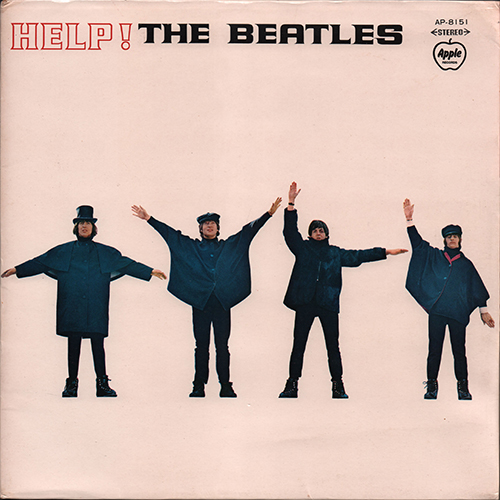 |
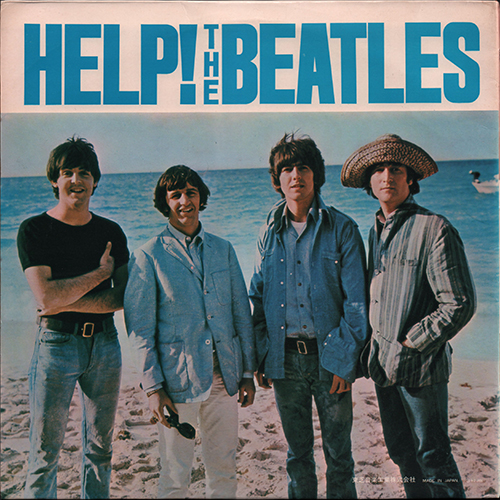 |
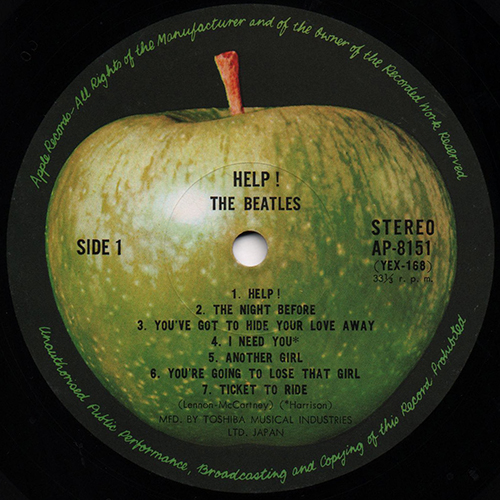 |
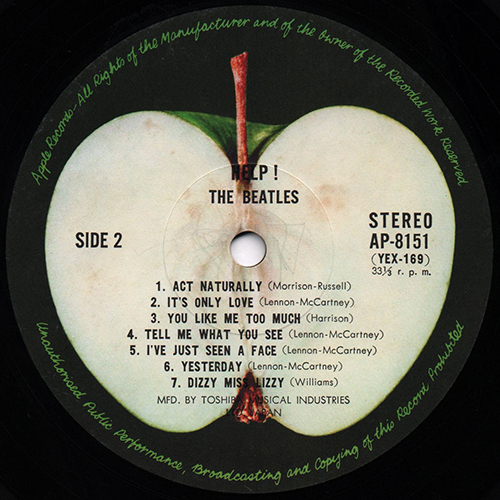 |
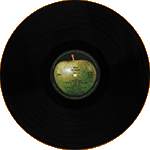 |
|
| INSIDE (Gatefold Cover) |
LYRIC SHEET (Slip Type) | ||||
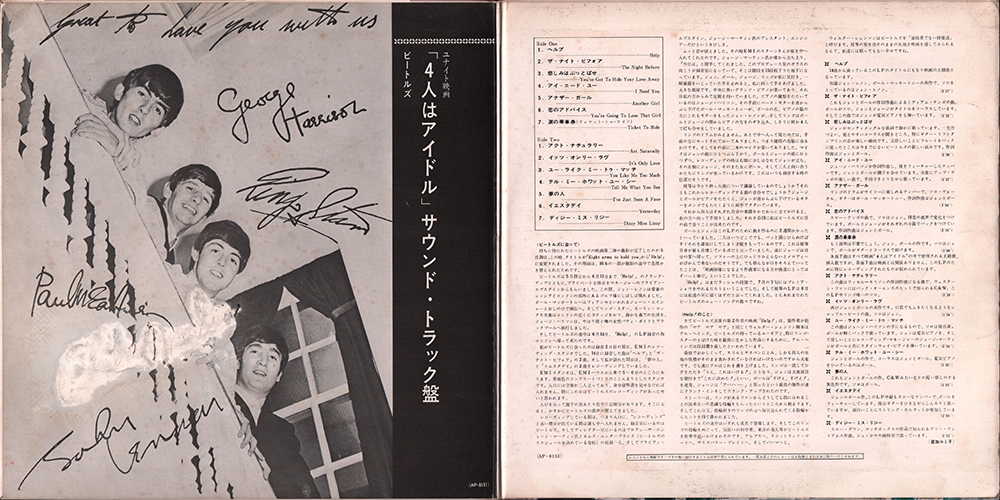 |
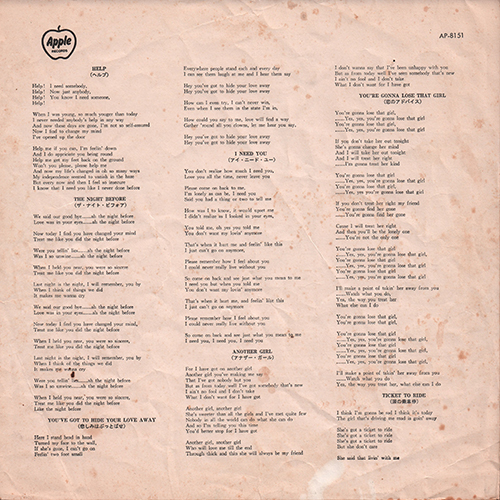 |
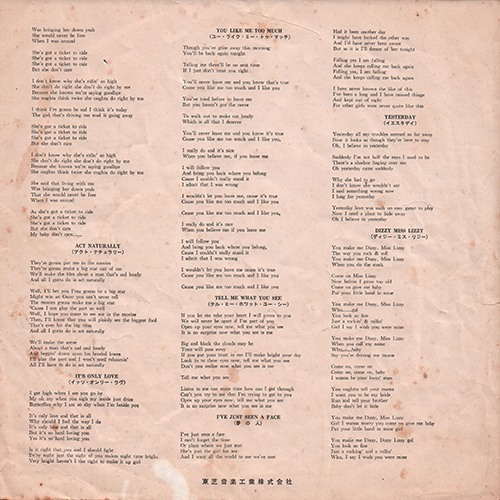 |
The lyric sheet is slip
sheet type. |
||
| LYRIC SHEET (Slip Type): CLOSE UP | INNER SLEEVE |
||||
 |
 |
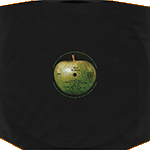 |
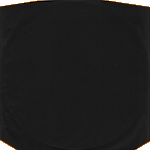 |
||
| Catalogue number "AP-8151" and
"Toshiba Musical Industries Ltd." were printed on the lyric
sheet. Apple custom black inner sleeve. |
|||||
| Apple Green Arrow
OBI CLOSE UP (Sorry, I don't have it) |
|||||
| FRONT | BACK | ||||
| 4th. pressing had a Apple
"arrow" OBI and priced ¥2,000 on rear sleeve and obi strip. |
The
obi remains intact with the order form on the back uncut. |
||||
| FRONT AND BACK COVER CLOSE UP | |||||
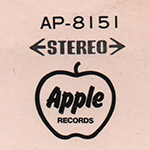 |
 |
||||
| Apple
logo mark and catalog number "AP-8151" were printed at the
upper right of the front cover. "H ¥2,000", and "Toshiba Musical Industries Ltd." were printed at the bottom of the back cover. |
|||||
| COVER INSIDE CLOSE UP | |||||
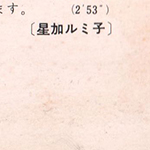 |
"Ever Clean" logo mark was removed on the
inside of the cover. Liner notes: Rumiko Hoshika. |
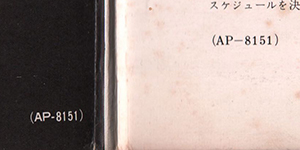 |
The words "PAT.P" was not embossed at the
bottom of the center of the inside. |
||
| LABEL CLOSE UP | |||||
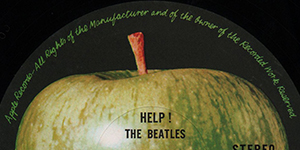 |
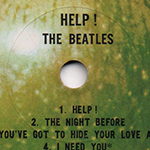 |
In 1969,
Toshiba had to reissue on the Apple label all the records
previously issued on the Odeon label. The phrase "Apple Records - All Rights of the Manufacturer and of the Owner of the Recorded work Reserved." was printed at the perimeter. |
|||
| LABEL CLOSE UP | |||||
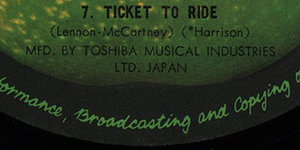 |
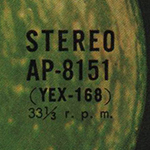 |
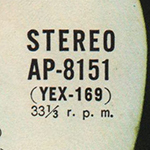 |
The words "MFD. BY TOSHIBA
MUSICAL INDUSTRIES LTD. JAPAN" was printed at the bottom of
the label.Catalog No. "AP-8151" and matrix number were
printed at the right side of the center hole. |
||
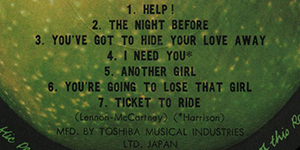 |
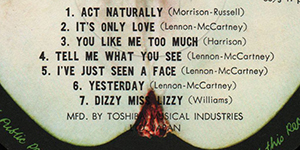 |
Song title and composer's name were
printed on the label. |
|||
|
OTHER ITEM
|
|||||
| - |
|||||
| RECORD LABEL | Dark Green Apple label Type-1 |
||||
| MIX | STEREO |
||||
| MATRIX No. | SIDE 1 | YEX-168-3
23 |
|||
| SIDE 2 | YEX-169-3 21 |
||||
| PRESS MARK | 0B
> C0 |
||||
| VINYL COLOR | BLACK |
||||
| RECORD COMPANY'S NAME | SLEEVE | Toshiba
Ongaku kogyo Kabusikigaisha |
|||
| LABEL | MFD. BY
TOSHIBA MUSICAL INDUSTRIES LTD. JAPAN |
||||
| SYMBOL/PRICE | H - ¥2,000 |
||||
| LYRIC SHEET STYLE | Slip Sheet Type |
||||
| COVER FORM | Gatefold type. (Soft Cover) |
||||
| INNER SLEEVE |
Apple custom black sleeve |
||||
| OBI |
Green / white so called "Apple Arrow" OBI
/ with Order sheet (¥2,000) |
||||
| COVER DESIGN/ PHOTO/ NOTES | Photography Robert Freeman Liner Notes: Rumiko Hoshika |
||||
|
COMMENTS
|
Dark green Apple label
Type-1with black print. Black vinyl. In late (September?)1969, Toshiba had to reissue on the Apple label all the records previously issued on the Odeon label. And in the Apple label, there are two subtypes, TOSHIBA MUSIC and TOSHIBA EMI. Further more, the early copies of the APPLE-TOSHIBA MUSIC type have dark Apple on its label, though the late copies have light one. Red vinyl: Besides good sound and quality printing, Japanese records also offered some other things of interest to the collector. One of the primary manufacturing companies in Japan, Toshiba, pressed a lot of their records on red, “Everclean” vinyl from 1958 through 1974 (maybe). While not pressed as collectors’ items, these red vinyl pressings are more sought out by collectors than their black vinyl counterparts. The Everclean vinyl was designed to be less prone to collecting static electricity and dust than the more common black vinyl. This LP was manufactured two ways: both Black and Red vinyl. The obi: A. K. A."Arrow" Obi 4th. and 5th. pressings had a green / white so called "Arrow" OBI and priced ¥2000 on rear sleeve and obi strip. On June 1967, starting with "Oldies (OP-8016)", numbering for new Odeon LPs changed to the 8000 range numbers. So Obis were renew, A.K.A. Odeon "Arrow Obi" in green and with the same design as the Apple Obis. While most Japanese records feature local music, a lot of music fans there like foreign music, as well. The language barrier in Japan presented a problem – should foreign album covers be changed for Japanese albums? The solution was the obi, which means “belt” or “sash”. The obi is a strip of paper, usually about two inches wide, that wraps vertically around the album cover, containing information about the artist and album in Japanese. As these strips of paper were fragile and easily torn, they are often missing, especially since consumers in the 1950s and 1960s attached little significance to them. Finding Japanese records made prior to 1970 that still have the obi intact can be quite difficult, and for some albums, nearly impossible. The inclusion of the obi can dramatically affect the price of some Japanese records, sometimes increasing the price by a factor of ten. |
||||
| TITLE | HELP! |
||||
| CATALOG NUMBER | AP-8151 |
||||
| RELEASE DATE | August 1971? / 5th. Press | ||||
| TRACK LISTING | SIDE 1 | SIDE 2 | |||
| Help! |
Act Naturally |
||||
| The Night Before |
It's Only Love |
||||
| You've Got To Hide Your Love Away |
You Like Me Too Much |
||||
| I Need You |
Tell Me What You See |
||||
| Another Girl |
I've Just Seen A Face |
||||
| You're Going To Lose That Girl |
Yesterday |
||||
| Ticket To Ride |
Dizzy Miss Lizzy |
||||
| FRONT --> Click! | BACK --> Click! | SIDE 1 --> Click! | SIDE 2 --> Click! | DISK | |
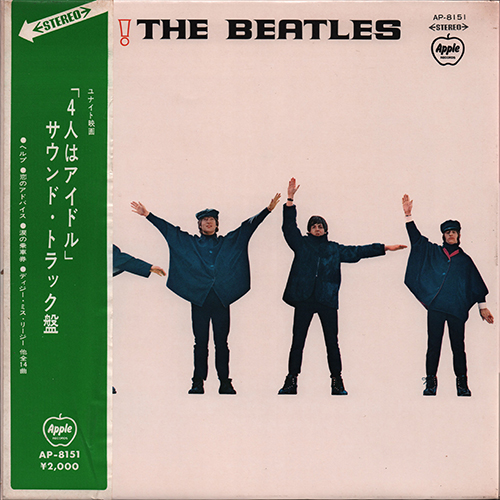 |
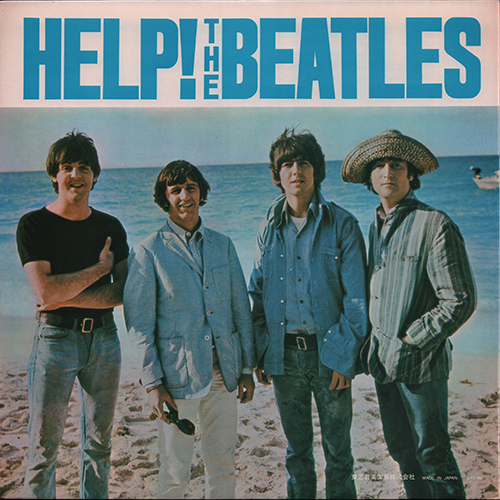 |
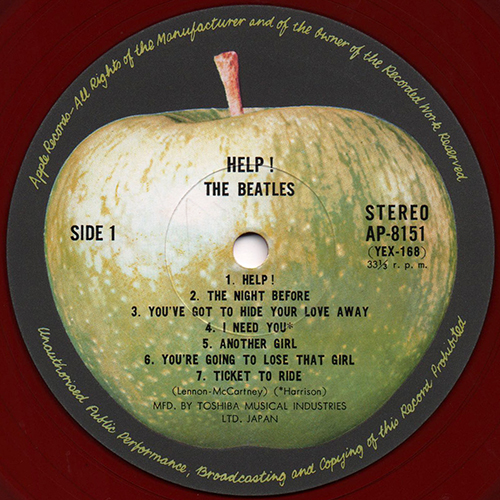 |
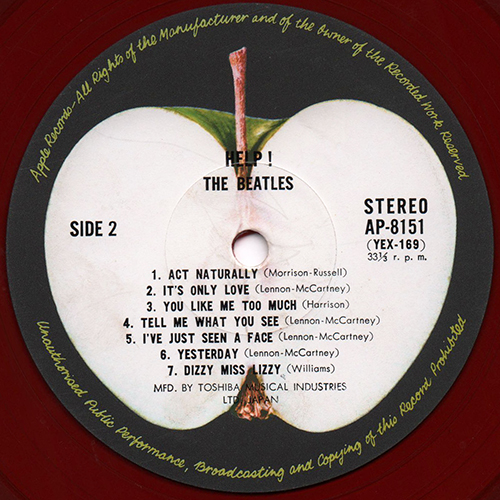 |
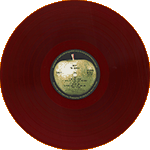 |
|
| INSIDE (Gatefold Cover) |
LYRIC SHEET (Slip Type) | ||||
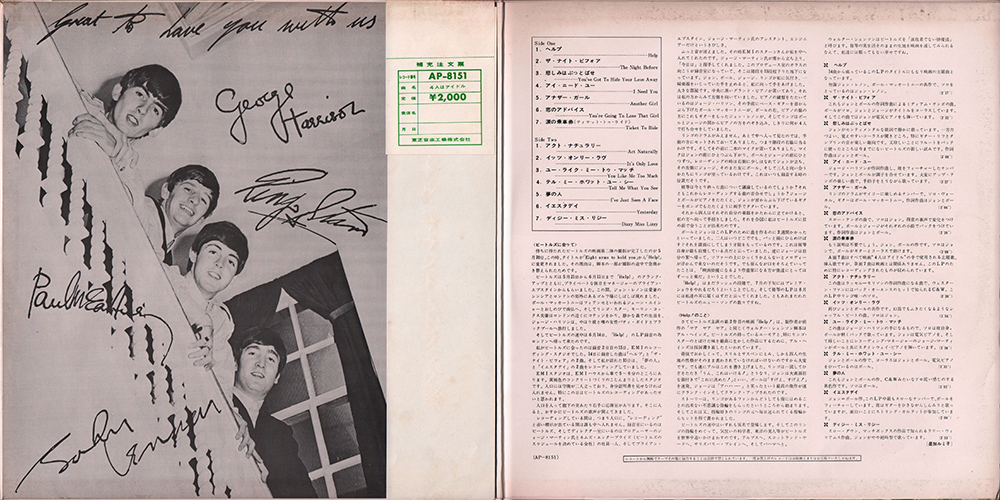 |
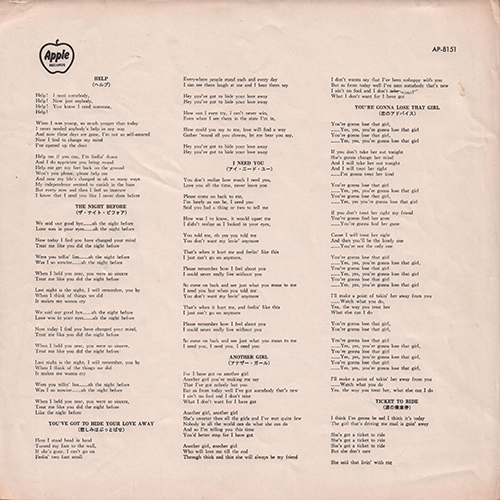 |
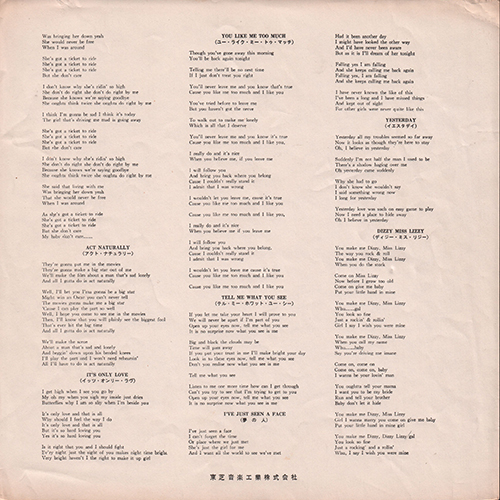 |
The lyric sheet is slip
sheet type. |
||
| LYRIC SHEET (Slip Type): CLOSE UP | INNER SLEEVE |
||||
 |
 |
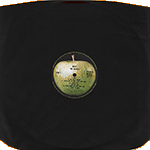 |
 |
||
| Catalogue number "AP-8151" and
"Toshiba Musical Industries Ltd." were printed on the lyric
sheet. Apple custom black inner sleeve. |
|||||
| Apple Green Arrow
OBI CLOSE UP |
|||||
| FRONT | BACK --> Click! | ||||
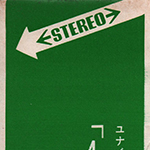 |
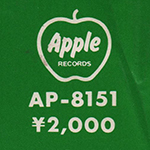 |
5th. pressing had a green "arrow"
OBI and priced ¥2,000 on rear sleeve and obi strip. |
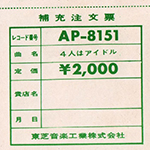 |
The obi remains intact
with the order form on the back uncut. |
|
| FRONT AND BACK COVER CLOSE UP | |||||
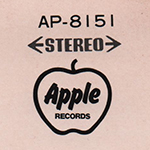 |
 |
||||
| Apple
logo mark and catalog number "AP-8151" were printed at the
upper right of the front cover. "H ¥2,000", and "Toshiba Musical Industries Ltd." were printed at the bottom of the back cover. |
|||||
| COVER INSIDE CLOSE UP | |||||
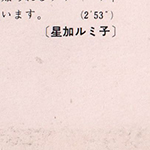 |
"Ever Clean" logo mark was removed on the
inside of the cover. Liner notes: Rumiko Hoshika. |
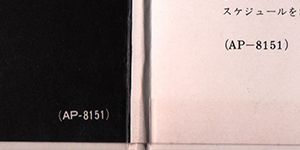 |
The words "PAT.P" was not embossed at the
bottom of the center of the inside. |
||
| LABEL CLOSE UP | |||||
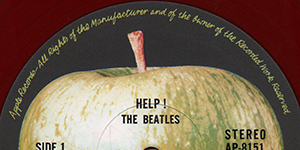 |
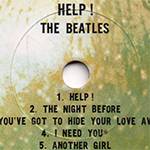 |
In 1969,
Toshiba had to reissue on the Apple label all the records
previously issued on the Odeon label. The phrase "Apple Records - All Rights of the Manufacturer and of the Owner of the Recorded work Reserved." was printed at the perimeter. |
|||
| LABEL CLOSE UP | |||||
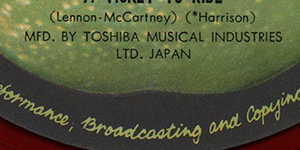 |
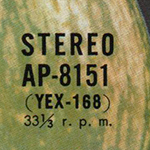 |
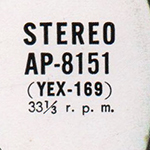 |
The words "MFD. BY TOSHIBA
MUSICAL INDUSTRIES LTD. JAPAN" was printed at the bottom of
the label.Catalog No. "AP-8151" and matrix number were
printed at the right side of the center hole. |
||
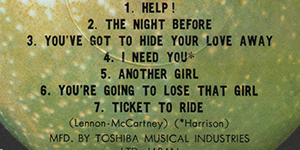 |
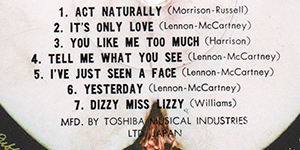 |
Song title and composer's name were
printed on the label. |
|||
|
OTHER ITEM
|
|||||
| TRACK LIST SHEET |
CLOSE UP |
||||
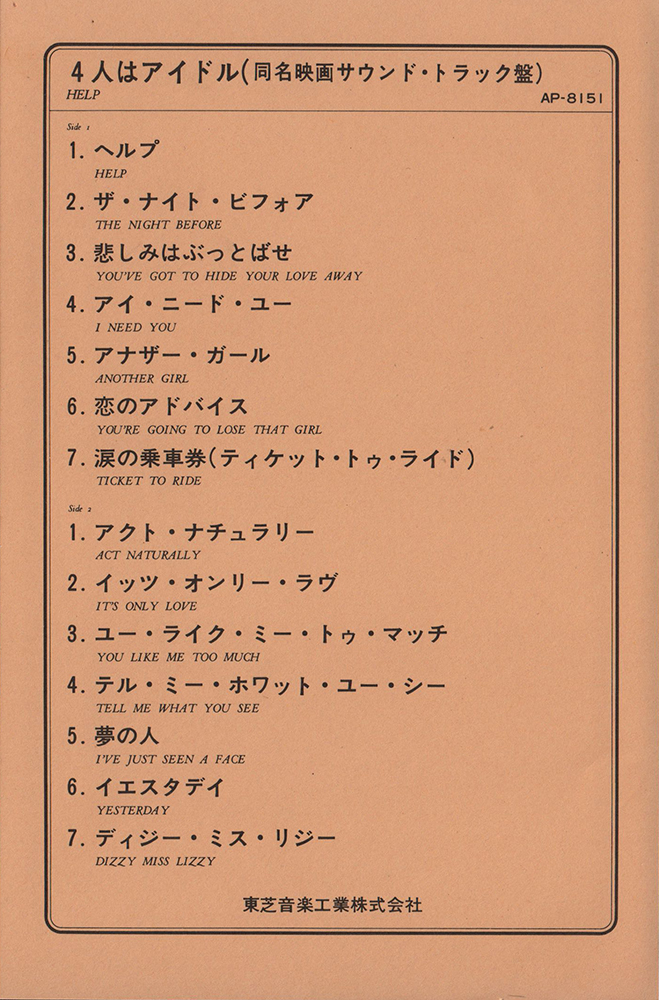 |
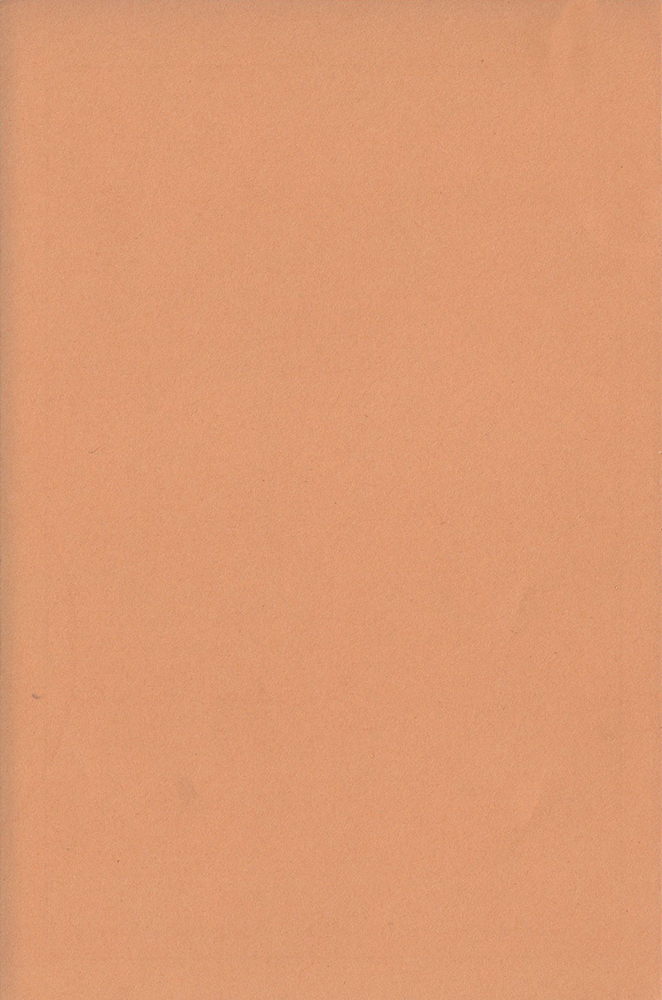 |
 |
|||
 |
|||||
With a track list sheet. |
|||||
| RECORD LABEL | Light Green Apple label Type-2-1 |
||||
| MIX | STEREO |
||||
| MATRIX No. | SIDE 1 | YEX-168-3
29 |
|||
| SIDE 2 | YEX-169-3 31 |
||||
| PRESS MARK | 1H |
||||
| VINYL COLOR | RED |
||||
| RECORD COMPANY'S NAME | SLEEVE | Toshiba
Ongaku
kogyo Kabusikigaisha |
|||
| LABEL | MFD. BY
TOSHIBA MUSICAL INDUSTRIES LTD. JAPAN |
||||
| SYMBOL/PRICE | H - ¥2,000 |
||||
| LYRIC SHEET STYLE | Slip Sheet Type |
||||
| COVER FORM | Gatefold type. (soft cover) | ||||
| INNER SLEEVE |
Apple custom black sleeve |
||||
| OBI |
Green / white so called "Apple Arrow" OBI
/ with Order sheet (¥2,000) |
||||
| COVER DESIGN/ PHOTO/ NOTES | Photography Robert Freeman Liner Notes: Rumiko Hoshika |
||||
|
COMMENTS
|
Light green Apple
label Type-1with black print. Red vinyl. In late (September?)1969, Toshiba had to reissue on the Apple label all the records previously issued on the Odeon label. And in the Apple label, there are two subtypes, TOSHIBA MUSIC and TOSHIBA EMI. Further more, the early copies of the APPLE-TOSHIBA MUSIC type have dark Apple on its label, though the late copies have light one. Red vinyl: Besides good sound and quality printing, Japanese records also offered some other things of interest to the collector. One of the primary manufacturing companies in Japan, Toshiba, pressed a lot of their records on red, “Everclean” vinyl from 1958 through 1974 (maybe). While not pressed as collectors’ items, these red vinyl pressings are more sought out by collectors than their black vinyl counterparts. The Everclean vinyl was designed to be less prone to collecting static electricity and dust than the more common black vinyl. The obi: A. K. A."Arrow" Obi 5th. pressing had a green / white so called "Arrow" OBI and priced ¥2,000 on rear sleeve and obi strip. On June 1967, starting with "Oldies (OP-8016)", numbering for new Odeon LPs changed to the 8000 range numbers. So Obis were renew, A.K.A. Odeon "Arrow Obi" in green and with the same design as the Apple Obis. While most Japanese records feature local music, a lot of music fans there like foreign music, as well. The language barrier in Japan presented a problem – should foreign album covers be changed for Japanese albums? The solution was the obi, which means “belt” or “sash”. The obi is a strip of paper, usually about two inches wide, that wraps vertically around the album cover, containing information about the artist and album in Japanese. As these strips of paper were fragile and easily torn, they are often missing, especially since consumers in the 1950s and 1960s attached little significance to them. Finding Japanese records made prior to 1970 that still have the obi intact can be quite difficult, and for some albums, nearly impossible. The inclusion of the obi can dramatically affect the price of some Japanese records, sometimes increasing the price by a factor of ten. |
||||
